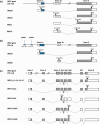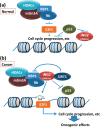Reviewing the current classification of inhibitor of growth family proteins
- PMID: 19432890
- PMCID: PMC2790152
- DOI: 10.1111/j.1349-7006.2009.01183.x
Reviewing the current classification of inhibitor of growth family proteins
Abstract
Inhibitor of growth (ING) family proteins have been defined as candidate tumor suppressors for more than a decade. Recent emerging results using siRNA and knockout mice are expanding the previous understanding of this protein family. The results of ING1 knockout mouse experiments revealed that ING1 has a protective effect on apoptosis. Our recent results showed that ING2 is overexpressed in colorectal cancer, and induces colon cancer cell invasion through an MMP13-dependent pathway. Knockdown of ING2 by siRNA induces premature senescence in normal human fibroblast cells, and apoptosis or cell cycle arrest in various adherent cancer cells. Taken together, these results suggest that ING2 may also have roles in cancer progression and/or malignant transformation under some conditions. Additionally, knockdown of ING4 and ING5 by siRNA shows an inhibitory effect on the transition from G(2)/M to G(1) phase and DNA replication, respectively, suggesting that these proteins may play roles during cell proliferation in some context. ING family proteins may play dual roles, similar to transforming growth factor-beta, which has tumor suppressor-like functions in normal epithelium and also oncogenic functions in invasive metastatic cancers. In the present article, we briefly review ING history and propose a possible interpretation of discrepancies between past and recent data.
Figures



Similar articles
-
ING1 and ING2: multifaceted tumor suppressor genes.Cell Mol Life Sci. 2013 Oct;70(20):3753-72. doi: 10.1007/s00018-013-1270-z. Epub 2013 Feb 15. Cell Mol Life Sci. 2013. PMID: 23412501 Free PMC article. Review.
-
A novel crosstalk between the tumor suppressors ING1 and ING2 regulates androgen receptor signaling.J Mol Med (Berl). 2016 Oct;94(10):1167-1179. doi: 10.1007/s00109-016-1440-1. Epub 2016 Jun 16. J Mol Med (Berl). 2016. PMID: 27305909
-
ING tumor suppressor proteins are critical regulators of chromatin acetylation required for genome expression and perpetuation.Mol Cell. 2006 Jan 6;21(1):51-64. doi: 10.1016/j.molcel.2005.12.007. Mol Cell. 2006. PMID: 16387653
-
ING proteins as potential anticancer drug targets.Curr Drug Targets. 2009 May;10(5):442-54. doi: 10.2174/138945009788185059. Curr Drug Targets. 2009. PMID: 19442116 Free PMC article. Review.
-
The ING tumor suppressors in cellular senescence and chromatin.Cell Biosci. 2011 Jul 18;1(1):25. doi: 10.1186/2045-3701-1-25. Cell Biosci. 2011. PMID: 21767350 Free PMC article.
Cited by
-
Transcriptional Regulation of ING5 and its Suppressive Effects on Gastric Cancer.Front Oncol. 2022 Jun 7;12:918954. doi: 10.3389/fonc.2022.918954. eCollection 2022. Front Oncol. 2022. PMID: 35747809 Free PMC article.
-
The ING4 Binding with p53 and Induced p53 Acetylation were Attenuated by Human Papillomavirus 16 E6.PLoS One. 2013 Aug 13;8(8):e71453. doi: 10.1371/journal.pone.0071453. eCollection 2013. PLoS One. 2013. PMID: 23967213 Free PMC article.
-
EBNA3C attenuates the function of p53 through interaction with inhibitor of growth family proteins 4 and 5.J Virol. 2011 Mar;85(5):2079-88. doi: 10.1128/JVI.02279-10. Epub 2010 Dec 22. J Virol. 2011. PMID: 21177815 Free PMC article.
-
Citrullination of inhibitor of growth 4 (ING4) by peptidylarginine deminase 4 (PAD4) disrupts the interaction between ING4 and p53.J Biol Chem. 2011 May 13;286(19):17069-78. doi: 10.1074/jbc.M111.230961. Epub 2011 Mar 22. J Biol Chem. 2011. PMID: 21454715 Free PMC article.
-
Fng1 is involved in crosstalk between histone acetylation and methylation.Curr Genet. 2021 Aug;67(4):535-538. doi: 10.1007/s00294-021-01167-2. Epub 2021 Feb 28. Curr Genet. 2021. PMID: 33641041 Review.
References
-
- Soliman MA, Riabowol K. After a decade of study‐ING, a PHD for a versatile family of proteins. Trends Biochem Sci 2007; 32: 509–19. - PubMed
-
- Doyon Y, Cayrou C, Ullah M et al . ING tumor suppressor proteins are critical regulators of chromatin acetylation required for genome expression and perpetuation. Mol Cell 2006; 21: 51–64. - PubMed
Publication types
MeSH terms
Substances
Grants and funding
LinkOut - more resources
Full Text Sources
Miscellaneous

